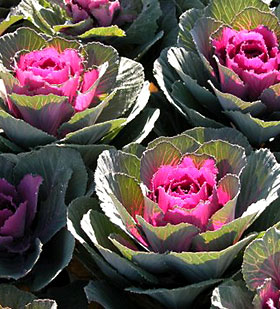
Brassica oleracea
During the cool conditions of fall, these close relatives of cabbage develop an intense purple or white color in the developing leaves that make them appear like large, showy flowers. Varieties have been selected that have elongated stems, making them useful in large fall bouquets.
Propagation:
- As with other cabbage family plants, seeds are sown in containers and transplanted after 4 to 5 weeks.
- Transplant cell size trays of 72 to 144 cells are adequate for propagation.
- Seeds germinate in 7 to 10 days in early July.
- Sow 3 months before cool fall weather.
Growing:
- Plants should be crowded to keep heads small: spacing of 6 x 6 in.
- Horizontal netting to provide plant support will be needed to prevent lodging.
- Strip lower leaves as stem starts to elongate, and repeat several times as plants grow.
- Keep a close watch for aphids which tend to disfigure these plants in cool weather.
- Since color development is aided by cool weather in fall, provide adequate ventilation.
Varieties:
- The open-pollinated ‘Sunrise’, with creamy white center, and ‘Sunset’, with red center, are commonly grown.
- F-1 hybrid ‘Crane’ series varieties come in red, white, pink and bicolor centers, and are more attractive and uniform than the open-pollinated lines (above right).
Postharvest Handling:
- Heads will last 1 to 2 weeks in water after harvest.
- Head color may change gradually to green if plants face warm conditions.
For more information, see: Armitage, A.M. and J.M. Laushman. 2003. Specialty Cut Flowers, 2nd Edition. Timber Press, 586 pp. Available through ASCFG.


